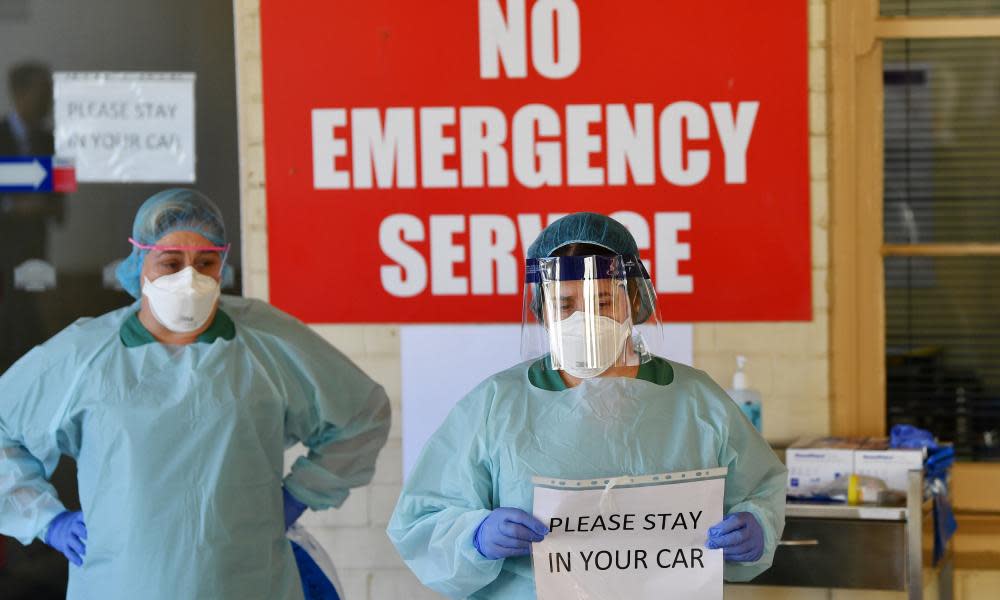Australian governments warn public services may struggle as coronavirus spreads

As the World Health Organisation warned the threat of a global coronavirus pandemic “has become very real”, Australian governments have cautioned they may struggle to keep services running if the health crisis becomes acute.
Infections globally have passed 110,000, but the vast majority – 93% – are in just four countries: China, South Korea, Iran, and Italy.
In Australia, 100 people have been confirmed with cases of Covid-19. Three people have died. NSW is the most affected state, with 55 confirmed cases.
In Victoria, the state’s chief health officer, Brett Sutton, warned that every person had a 50-50 chance of contracting the illness. He said efforts by medical authorities were an attempt to delay the peak of the virus’s spread to July, but he conceded the peak could come as soon as May.
He said social distancing measures, including school closures and the possible cancellation of mass gatherings, would continue, but that the pandemic phase would almost certainly be over by Christmas.
Related: Coronavirus has so far cost average the Australian superannuation balance $5,900, data shows
Victoria has now recorded cases of human-to-human transmission of the Sars-Cov-2 virus, which causes Covid-19.
The premier, Daniel Andrews, gathered his cabinet’s security and emergency management committee to discuss the crisis, including its expected impact on the public sector – about 310,000 people in the state.
“Clearly, being able to maintain all forms of public service at a time when our own workforce is likely to be impacted is going to be a challenge,” the Victorian attorney-general, Jill Hennessy, said.
Hennessy said the impact of coronavirus on casual workers – who have no access to sick leave but might be forced to self-isolate – would also be discussed.
“I would hope that people can bring a spirit of pragmatic compassion to all of those challenges,” she said.
“If you are in vulnerable employment circumstances, it’s pretty difficult to survive without that funding and I know that’s something that is being discussed at an ongoing level at intergovernmental forums.”
Victoria’s dedicated Covid-19 phone line and the Nurse-On-Call Hotline crashed on Tuesday because of an influx of calls, and a former Australian Medical Association head resorted to swabbing patients in a car park.
“We thank the community for their patience as we work to increase the capacity of the hotlines – including putting on additional staff,” Ambulance Victoria said on Tuesday.
Six cases of Covid-19 have been confirmed in Western Australia, and three coronavirus clinics opened on Tuesday at three hospital. More can be opened on an as-needed basis.
The message from the federal government, meanwhile, is “upscaling”.
“Now is the moment of pressure, so we’re upscaling, the states are upscaling, the GPs are upscaling,” said the federal health minister, Greg Hunt, at a press conference on Tuesday afternoon.
That “upscaling” included reviewing travel advisories for Italy, where infection rates have been rapidly rising; diverting staff to the inundated coronavirus information hotline; and ensuring that GPs and hotline operators had clear instructions on where to send people for testing, with many people having been referred to clinics that were not testing for Covid-19.
Hunt also acknowledged growing community concerns about precarious or casual workers, for whom the quarantine requirements or a period of prolonged illness may be particularly detrimental.
The attorney-general, industrial relations minister, and the chief medical officer had “met at a round table with employers and employees” to discuss maintenance of those workers and their livelihoods, Hunt said.
“I think that’s a very important part of preparedness but also in terms of equity,” he said. He did not discuss the outcomes of that meeting.
There were no recommendations yet for a complete lockdown of any areas of Australia, said the chief medical officer, Brendan Murphy.
Murphy also sought to clarify who should or should not present for testing for the virus.
“Our focus at the moment is testing people who are returned travellers who have acute respiratory symptoms, cough sore throat and the like, and contacts of confirmed cases,” he said.
Related: Coronavirus: Australian bushfire relief concert cancelled after Miley Cyrus pulls out
“At the moment we are not recommending that general members of the community with acute respiratory symptoms – colds, flu, and the like – be tested.”
He said wider testing might be undertaken if community transmission increased.
The ASX steadied to be up by almost 1.2% with two hours of trade left in the day on Tuesday, a dramatic turnaround from the grim picture at the opening of trade, when the benchmark ASX 200 index tumbled 3.7%.
US president Donald Trump’s announcement of a stimulus package shortly after 10am Australian time reversed what was looking to be a second day of heavy losses.
The World Health Organization defines a pandemic as a scenario in which “the whole world’s population would likely be exposed to this infection and potentially a proportion of them fall sick,” said Michael Ryan, the head of the WHO’s emergencies programme, said.
He stressed, “even if we call it a pandemic, still we can contain it and control it”.
“It would be the first pandemic in history that can be controlled. We are not at the mercy of the virus.”

 Yahoo News
Yahoo News 
